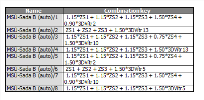1D stresses
The 1D internal forces command serves for displaying internal forces on selected 1D members. (not only on Beams, but also on Ribs, Tendons and Integration strips/members)
Usage
- Calculate a FEM analysis of the model
- Go to Tree > Results > Beams > 1D stresses
- Set properties of the command to specify mainly:
- Click on [Refresh] action button to display the results
Note: To get general overview about how to work with Result service and its commands, see Results/Basics.
Properties
| Category | Property | Description / Notes |
|---|---|---|
| Selections |
Type of selection All / Current / Advanced / Named Selection
|
Specifies on what members the results are displayed
|
| Filter
No / Cross-section / Material / WildCard / Layer / Type of beam |
||
| Result case | Type of load
Load case / Combinations / Classes / Nonlinear Combinations/ Stability Combinations / Mass combinations |
Defines for what load the results are displayed. |
| Extreme 1D | Extreme 1D
Section / local / Cross-section / Design group / Member / Global |
Defines the position where extremes of result value are evaluated.
|
| Type of values
Basic magnitudes / Principal magnitudes |
||
| Values | See table Values below. | |
|
Fibres All / Top / Bottom / Named fibre / All named fibres |

|
|
|
Cross-section parts |
||
|
Consider torsion due to shear centre eccentricity On / Off |
With this option ON, the shear forces are considered to act in the centre of gravity and therefore the shear stresses are magnified by additional torsion effect from eccentricity of shear forces. Shear stresses on 1D members are calculated by default from shear forces and torsion moment, where shear forces are considered to act in the shear centre of the beam's cross-section. In case of cross-section with different position of shear centre with respect to the centroid of gravity this approach leads to discrepancy in the position of acting forces. Typical example of such cross-section is hot-rolled U shaped cross-section. |
|
|
Print combination key On / Off |

|
|
|
Results in sections All / Selected |
If results in sections is set on Selected, new possibilities are available Ends / Close to middle / Inputted |
|
| Drawing Setup 1D | " Drawing setup 1D" | |
| Errors, warnings and notes settings | "Errors, warnings and notes settings" |
Values
The following categories of 1D stresses can be displayed:
Basic magnitudes
The basic stresses are default magnitudes referring to the local axes of the selected coordination system.
| Value | Description | Notes |
|---|---|---|
| σx | It is calculated on assumption of linear distribution of the strain within the section. In the first step the plane of deformation is calculated using iterative algorithm () so strain in all fibres is known. In the next step adequate stresses are assigned using stress-strain curve. Remember that linear calculation uses linear approximation (E modulus) of stress-strain curve. | |
| txy | transverse shear stress from shear force Vy in direction of principal axis y |
The shear stress components are calculated from the principal shear forces (Vy, Vz) and torsional moment (Mx) using relevant unit shear stress factors (τxy,unit, τxz,unit, τtor,unit) from Cross-section characteristics.
|
| txz | transverse shear stress from shear force Vy in direction of principal axis z |
|
| ttor | shear stress from torsion moment Mx |
Principal magnitudes
The principal stresses represent the extreme values of the internal forces derived from the basic ones by transformation into the directions of principal axes:
| Value | Description | Notes |
|---|---|---|
| σ1 |
|
|
| σ2 | ||
| σE | ||
| ttot |






